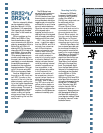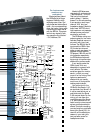
protection from RF interfer-
ence. (As you well know,
many installations suffer
from such problems.)
Metal lockwashers make
electrical contact between
the jack and outer chassis,
and an internal shunting
capacitor is placed from
each input to ground. This
routes RF back through the
metal chassis, where it is
dissipated before it can
propagate via the SR24•4
or 32•4’s circuit boards.
The SR Series consoles
have built-in power sup-
plies (instead of a “wall
wart,” which takes up pre-
cious outlet spaces and can
get lost or damaged), so
you’re sure to have plenty
of power. We could go on
and on, but suffice to say
that people who have
hauled their SR24•4s and
32•4s all over the country
will attest to their durability.
They’ll hold up to years of
use with nary a problem.
The main chassis of the
SR24•4 and SR32•4 mixing
consoles is made of solid steel
monocoque construction.
Because the steel doesn’t flex,
the console itself is quite
sturdy. And at the same time,
the SR Series consoles don’t
weigh a ton, either.
Controls are designed to
withstand serious downward
impact. From a fistpounding to
a heavy box dropping, the
SR Series’ knobs can take it.
We also use sealed controls
rather than open-frame
potentiometers that eventually
deteriorate from airborne
contamination. Switches are
ultra-high duty-cycle. And
inside, impact-resistant,
double-thru-hole-plated fiber-
glass circuit boards, brass
standoffs, and gold-plated
interconnects abound.
The SR24•4 and 32•4’s
60mm faders are made with
the same precision log taper
as those on our 8•Bus con-
soles. Besides giving smooth,
consistent fades, these faders
were built to last. They have a
newly-developed, ultra-tight
lip seal made of a special
co-polymer membrane that
provides a continuously-
sealed barrier against dust
and liquid, yet doesn’t
interfere with fader travel.
There’s more. 1/4” jack
sleeves are metal, not
plastic. That’s part of the
reason why the SR24•4 and
32•4 have such exceptional
•
•
•
•
•
•
•
•
•
•
•
•
•
•
••
•
•
•
•
•
•
•
•
•
•
•
•
•
•
•
•
•
•
•
•
•
•
•
•
•
•
•
•
•
•
•
•
••
•
•
•
•
•
•
•
•
•
•
•
•
••
•
•
•
•
•
•
•
•
•
•
•
•
1
2
3
TRIM: MIC GAIN-
+10 to +60 dB
LINE GAIN-
-10 to +40 dB
LO CUT
MUTE
INSERT
-20 dB LED
EQ
LO MID HI
80 8k 12k
100-
GAIN
FREQ
GAIN
FREQ
FADER
PAN
O/L LED
ASSIGN
SWITCHES
1-2
3-4
L-R
SOLO IN
PLACE
PFL
LOGIC
MUTE LED
(STEADY)
SOLO LED
(FLASHING)
AUX 1
AUX 2
AUX 3
AUX 4
AUX 5
AUX 6
PRE
MONO
INPUT
CHANNEL
SR 24•4 (1 of 20)
SR32•4 (1 of 32)
BOLD LINES INDICATE
SIGNAL PATH FROM MIC
INPUT TO LEFT MAIN OUTPUT.
LEFT
(MONO)
RIGHT
TRIM
-20dB
LED
MUTE
LO LO- HI- HI
MID MID
LO LO- HI- HI
80 800 3k 12k
MID MID
O/L
LED
FADER
LINE GAIN-
-20 TO +20dB
+
-
+
-
+
-
MUTE LED
(STEADY)
SOLO LED
(FLASHING
AUX 1
AUX 2
AUX 3
AUX 4
AUX 5
AUX 6
PRE
STEREO
INPUT
CHANNEL
(1 OF 2)
MACKIE SR24•4/SR32•4
BLOCK DIAGRAM Rev. 1.5 5/11/95
STOPLIGHT
EXIT 27B
316 GLENDALE
(KNOCK FIRST)
TALKBACK
XLR INPUT
LEVEL
TB TO AUX 1-2
TB TO L-R MIX
MIC
IN
LINE
IN
SUB 1
SUB 2
SUB 3
SUB 4
L MIX
R MIX
•
Vp
•
•
•
•
•
1-2
3-4
L-R
SOLO IN
PLACE
PFL
LOGIC
•
80 800 3k 12k
•
•
•
•
•
PAN
•
PHANTOM POWER
(GLOBAL SWITCH)
MACKIE
MIC PREAMP
75Hz
HPF
®








